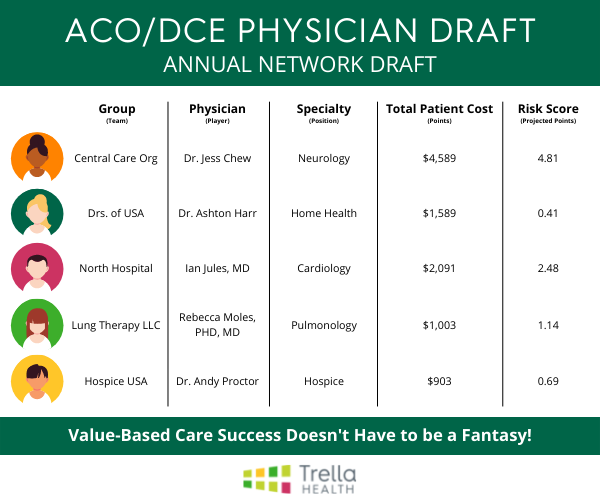EmmaKate Few, Business Development Rep
A member of Trella's Business Development team, EmmaKate enjoys employing the same energy, game planning, and consistency from her athletic background into the competitive yet rewarding world of healthcare analytics. From reporting from the XFL sidelines as the Dallas Renegades digital host to studio hosting as the Weekend Sports Anchor for KTAL in Shreveport, Louisiana, her passion for sports and public speaking has taken her across the globe. She is a 2020 Magna Cum Laude graduate of Southern Methodist University with degrees in Journalism, Applied Physiology and Sport Management, and Religious Studies. While at SMU, EmmaKate was a member of the Women's Cross Country team, was the ESPN Campus Correspondent, a published researcher for the NFL office in London, and one of the key faces of Mustangs football and basketball as the gameday emcee and host of the Live PonyUp Pregame Show.Approach ACO network Optimization Like A Fantasy Football Draft
Value-based Care Success Doesn’t Have to be a Fantasy !
By EmmaKate Few | September 13, 2021
Football season is here, and that means fantasy football leagues across the country are making their draft picks and kicking off the season. Whether you’ve thought about it this way or not, data-driven insights are the backbone of any good fantasy football team. There’s a reason that running backs like Christian McCaffrey are consistently drafted first overall, while household name quarterbacks don’t typically come off the board until the later rounds.
Yes, some fantasy owners draft their rosters by picking and choosing from their favorite players to watch on Sunday, but that’s typically not the best strategy. The owners that come out victorious at the end of the season are the ones who put bias aside and rely on data to piece together their dream teams.
As a Direct Contracting Entity (DCE), you’re in a unique position to craft your ‘dream’ roster too – by identifying the best clinicians in your market based on key metrics. Choosing providers without insight into their overall quality metrics, patient volume, and total cost of care is a lot like drafting your fantasy roster at random. These metrics are critical for ACOs and DCEs striving to meet CMS’ quality and cost benchmarks; for networking optimization and building, data can play a significant role in helping you succeed in risk-sharing payment programs.

Building Your Fantasy Provider Network with Data-Driven Insights
Championship-bound fantasy rosters are built through critical analysis of the point value that each player can contribute weekly on the starting lineup. Likewise, successful CMS-innovation models are dependent on physicians that can provide quality patient care while reducing healthcare costs. By analyzing the historical expenditures and patient outcomes of a provider, you can unlock insights that bring confidence to your risk-bearing entity’s ability to handle the risk.
The parallels between drafting a winning fantasy football roster and building out a successful DCE network don’t end there, though. In fantasy football, your goal is to choose the highest performing players from any NFL team and combine them to form the starting lineup of your dreams. Similarly, while ACOs must consider the impact of adding an entire physician group to their network, DCEs are in a unique position to pick and choose top-performing physicians down to the provider level. So, let’s talk about how you choose your top players and the best strategy to improve outcomes, decrease costs, and meet or exceed CMS’s performance benchmarks.
Primary Care Providers: The Running Backs of DCE and ACO Network Optimization
In fantasy football, every position matters, but stellar running backs are the backbone of any good team. Without strong running backs, you can basically kiss the playoffs goodbye. Draft a few strong running backs in the early rounds and you’ve got the most consistent, important point producers to rotate in your starting lineup.
In our analogy, primary care providers (PCPs) are the running backs of ACO and DCE network optimization. Without these consistent, high-performing players in your ACO or DCE, success is unlikely. Through over 14,500 metrics in Trella’s explore tab alone, risk-bearing entities can filter down to their service area and target PCPs that bring with them high beneficiary counts and historically lower average spending.
You’ll note that we’ve been speaking in plural terms for both running backs and PCPs. One star player, or even one strong position group, doesn’t always lead to a championship. Most leagues allow you to choose a starting lineup each week that fills these positions: two running backs, two wide receivers, one quarterback, one tight end, one kicker, a team defense, and one, sometimes two, “flex” players.
The real key to fantasy success is drafting a roster of consistent, point-producing players who have high potential to see a solid amount of game action. Again, we can draw the parallel with building your network, as you work to identify and “draft” a roster of key PCPs to carry you to success in value-based care.
Once you have identified the highest-value PCPs to add to your network, it’s time to think about your other “position players” – such as specialists and post-acute agencies – to add to your preferred provider list.
Building Your PAC Network: Are You Ready for the Whistle to Blow?
A strong PCP roster could get you to the playoffs (avoiding financial penalties), but taking the crown (earning financial incentives for high performance) is likely out of the question if you haven’t applied the same data-driven strategy in selecting your in-network post-acute care (PAC) providers.
Throughout the season, you have time prior to each week’s games to evaluate opponent(s), injuries, expected playing time, and other metrics. When the whistle blows, though, your destiny rides in the statistical performance of your active roster. Think of CMS’s deadlines to submit your provider list, remove/add SNF affiliates, submit sample agreements, etc. as game time. When that whistle blows and those deadlines come around, will you have a winning roster of top-performing providers ready to go?
Just like some fantasy leagues will provide insights on players’ value and expected performance, Trella’s Marketscape Strategy solution gives you access to data and insights you need for critical evaluation of potential clinician partners before you add them to your network. Instead of constructing your network with last-minute, pre-whistle decisions, take advantage of a tool to help you build your roster based on actual statistics.
Trella Health is the leader in market intelligence for the 65+ population, with extensive data sets including Medicare FFS, Medicare Advantage, commercial payers, ACOs, and DCEs. For more insights into how to make your dream network a reality, schedule a demo today.
Good luck this season!















